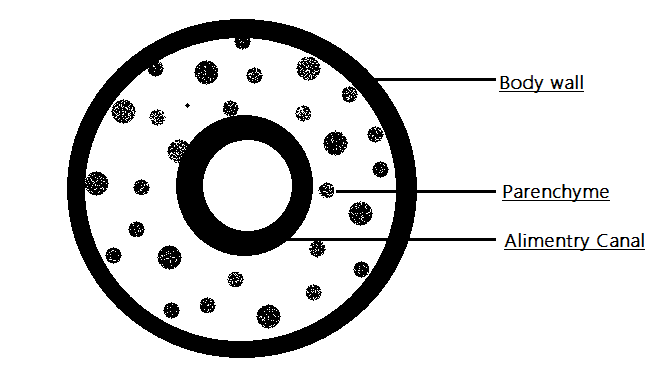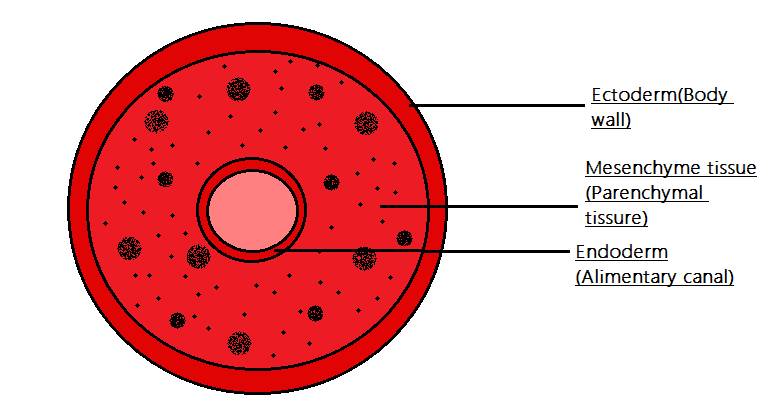
The cross-section of the body of an invertebrate is given below. Identify the animal which has this body plan.

A. Cockroach
B. Roundworm
C. Planaria
D. Earthworm

Answer
572.4k+ views
Hint: Platyhelminthes are triploblastic and acoelomate invertebrates. The coelom is not found in these animals. Between the body wall and alimentary canal, mesenchyme tissue is found. This is also called parenchyma tissue. Planaria is a member of Platyhelminthes.
Step by step answer:
On the basis of the presence of coelom and type of coelom, animals are classified. In cross-section, body plan Platyhelminthes looks like this-

The outermost layer represents the body wall. The innermost layer represents the endoderm and the middle layer is called the mesoderm. In Platyhelminthes no coelom (cavity) is found. At the time of embryonic development, three germ layers are made from outside towards inside, these are called ectoderm, mesoderm, and endoderm.
Later ectoderm develops in the body wall. The endoderm forms an alimentary canal and the mesoderm forms body organs.
In Platyhelminthes, mesoderm is found in the form of mesenchyme tissue. Not any cavity is found between the body wall and the alimentary canal. So these are called acoelomate.
In aschelminthes a cavity is found between the body wall and alimentary canal but the mesoderm is spitted, so these are called pseudocoelomates.
In phylum Annelida, the true coelom is found. It has a complete lining of mesoderm.
Hence option C is correct.
Note: From Annelida, all higher invertebrates and chordates are coelomate. Animals of Porifera and Coelenterata are diploblastic or diploblastic.
Step by step answer:
On the basis of the presence of coelom and type of coelom, animals are classified. In cross-section, body plan Platyhelminthes looks like this-

The outermost layer represents the body wall. The innermost layer represents the endoderm and the middle layer is called the mesoderm. In Platyhelminthes no coelom (cavity) is found. At the time of embryonic development, three germ layers are made from outside towards inside, these are called ectoderm, mesoderm, and endoderm.
Later ectoderm develops in the body wall. The endoderm forms an alimentary canal and the mesoderm forms body organs.
In Platyhelminthes, mesoderm is found in the form of mesenchyme tissue. Not any cavity is found between the body wall and the alimentary canal. So these are called acoelomate.
In aschelminthes a cavity is found between the body wall and alimentary canal but the mesoderm is spitted, so these are called pseudocoelomates.
In phylum Annelida, the true coelom is found. It has a complete lining of mesoderm.
Hence option C is correct.
Note: From Annelida, all higher invertebrates and chordates are coelomate. Animals of Porifera and Coelenterata are diploblastic or diploblastic.
Recently Updated Pages
Master Class 11 Business Studies: Engaging Questions & Answers for Success

Master Class 11 English: Engaging Questions & Answers for Success

Master Class 11 Computer Science: Engaging Questions & Answers for Success

Master Class 11 Social Science: Engaging Questions & Answers for Success

Master Class 11 Maths: Engaging Questions & Answers for Success

Master Class 11 Biology: Engaging Questions & Answers for Success

Trending doubts
Differentiate between an exothermic and an endothermic class 11 chemistry CBSE

10 examples of friction in our daily life

One Metric ton is equal to kg A 10000 B 1000 C 100 class 11 physics CBSE

Difference Between Prokaryotic Cells and Eukaryotic Cells

State the laws of reflection of light

Explain zero factorial class 11 maths CBSE




